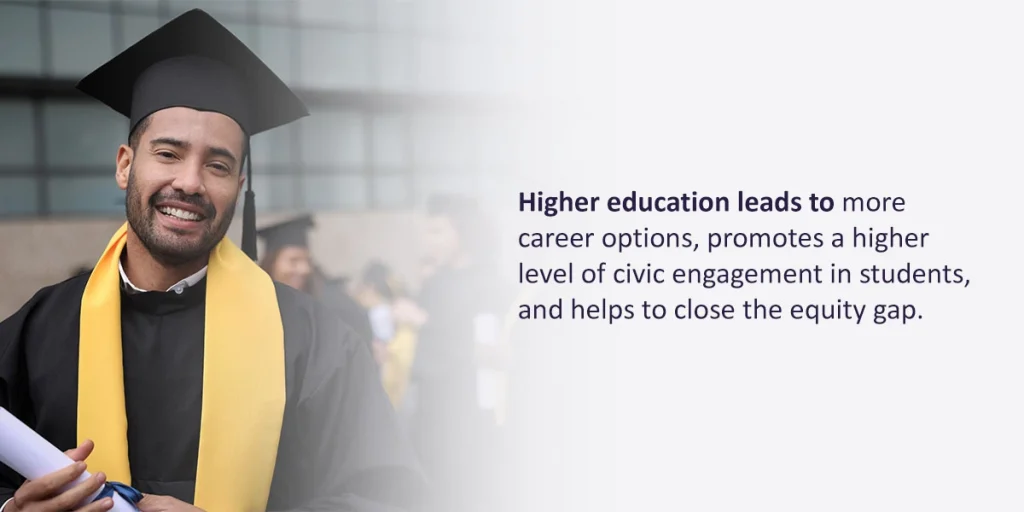Bias and systemic barriers can often restrict groups of people from achieving the same outcomes as others. Although some prefer to believe that the background and culture of a person are a direct reflection of personal preference, this is far from the truth and continues to discourage those who need additional resources to complete their education.
Equity refers to justice and fairness. It differs from equality because rather than providing the same opportunities to everyone, equity recognizes that everyone starts in different places, and you must make adjustments to accommodate them when necessary.
This guide to achieving equity discusses what equity in higher education is, how to implement it, and why equity in education is important to your students’ success.
What Does Equity Mean in Education?
Educational equity involves understanding the legal inequalities and lack of access to health and education that various groups of people face. Equity in higher education could include providing custom solutions to access resources, academic support, or funding to those who need it.
Equity in education means:
- Providing opportunities for students to learn in a way that fits their lifestyle
- Reducing barriers for underprivileged students to overcome disadvantages
- Increasing engagement with course material
- Strengthening familial connections and relationships with educators
- Guiding students to resources that can bolster their education
- Assisting first-generation college students to navigate through their education
- Improving the community and promoting civic engagement
- Preparing students to become economic providers
Higher education institutions have access to valuable tools that most people do not have the opportunity to encounter every day. Ensuring all students have the chance to use your state-of-the-art facilities, study abroad, take a course in your world-class science lab, or evaluate your renowned art collection will allow them to experience things they may not otherwise expose themselves to. These experiences can help them define their goals and focus on specific careers that they are interested in that they previously may have been unaware of.
Recognizing marginalized students is the first step to introducing equity to your institution. Implementing programs to allow them to use their voice and feel heard is a great way to enhance their learning experience and become aware of areas that need improvement in your institution. The bottom line is that educational equity allows each student to reach success.

Importance of Equity in Education
Higher education leads to more career options, promotes a higher level of civic engagement in students, and helps to close the equity gap. Higher education provides alternative paths to major life decisions and helps to create a more balanced and just society.
Reports show that white students are still the majority in higher education institutions, with just under 40% of enrolled students identifying as a race other than white in 2012, the most recent year data is available. There has been a recent increase in Black and Latino student enrollment, but they also remain the majority of those who drop out.
Furthermore, quality education can significantly impact a person’s potential earnings and employment prospects. Those who have some post-secondary education have a longer life expectancy. Additionally, degree holders are 47% more likely to receive health insurance through their jobs, and their employers contribute 74% more to their healthcare coverage.
Educational equity provides students with the resources they need to increase their chances of success and promote a bright future. Institutions need to offer opportunities to people of color and those from low-income families.
How to Address Equity in Higher Education
Equity-minded leaders reject the idea that cultural, social, and educational backgrounds cause inequities. They accept the need for change and embrace the chance for systemic transformation.
Educators need to keep students engaged to optimize their retention and can accomplish this through student success coaching. Success coaching entails assessing the whole person, spanning beyond their presence on campus or financial capability. Coaches evaluate how a person’s current employment, family commitments, housing or food circumstances, and health issues affect their lives and education. They can then provide students with the necessary resources to continue their academic journey.
Success coaches guide students to reach successful outcomes, and students value the relationship with a trusted professional as time goes on. Access to essential resources aids these students in completing their program and obtaining their degrees or certificates.
Additional steps to address equity could include:
- Using clear language: Describing goals and outcomes clearly is vital in encouraging students to succeed.
- Being mindful: Creating more accessible goals and achievements and removing barriers will enhance students’ educational experience.
- Making accommodations: Discovering areas where racial or ethnic groups are over- or under-represented can enable you to adjust courses, activities, programs, and requirements to include those who may not feel involved.
- Questioning assumptions: Having conversations with students about what they feel is lacking in your institution can reduce the assumptions that students are choosing to ignore the support available to them.
- Creating initiatives: Equity must permeate every aspect of the institution. All institutional members should recognize the purpose of their goals and be able to speak to their importance.
- Implementing programs: Success solutions such as Student Success & Engagement open a line of communication for students who need assistance and promote discussion amongst decision-makers who can implement additional changes and accommodations.
- Paving navigation pathways: Creating more ways to access higher education after high school can offer more students the opportunity to attend post-secondary school.
Faculty must understand the importance of reducing disparities. Consistent discussions and messaging about the urgency and importance of equitable policies and practices will promote conversations about equitable solutions for future challenges.
Training staff to be aware of practices that students may find hostile or alienating will decrease the likelihood of students feeling discouraged. Authentic opportunities for faculty to alter practices are essential to creating a safe and welcoming environment for everyone.

Watermark Student Success & Engagement
Watermark provides data measurement, collection, and analysis software that you can use in your institution to assess learning outcomes and track trends over time. You can use your data for further institutional planning and research to enhance your student’s educational experience.
Student Success & Engagement can help you increase student retention and optimize their chances of achieving certificate and degree completion. This software can help close the equity gap of your institution by identifying underserved students and keeping them engaged with materials.
Our software can make it easier to track attendance and notify you when students fall off track, so you can determine accommodations that will aid in their education and be proactive in reinforcing their decision to complete their program. Success coaches provide a one-on-one communication line for students to ask for additional resources and discuss challenges with a trusted professional.
Request a demo of Student Success & Engagement to find out what our software can help you do and begin closing the equity gap.

















































































































































































































































































































































































































